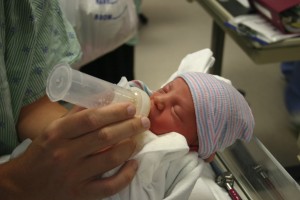CHOC is gaining recognition for a new breast milk handling process that is proving to be safer for patients and more efficient for physicians and staff.
With very few government regulations in place, hospitals across the country struggle to establish best practices in handling breast milk, and CHOC is no different. Busy nurses are often tasked with collecting, labeling, inventorying and distributing dozens of bottles during a shift, amid other critical responsibilities.
“Our nurses are doing a multitude of highly important things, often being pulled in many directions at once,” said Caroline Steele, director of CHOC’s Clinical Nutrition & Lactation Services. “Without good support and a better system in place, there was potential for interruptions and errors.”
In June 2011, CHOC’s Joint Leadership Committee formed a process improvement team, including physician co-chair Dr. Christine Bixby and representatives from each inpatient nursing unit, Clinical Nutrition and Lactation, Quality and Transport. The team reviewed data from the previous 12 months and identified 282 potential points where the existing process could fail, and 85 of those were named as top priorities to be addressed in a complete redesign of the system.
A New Method
In January 2013, the team moved milk preparation to a centralized location. The existing formula room was repurposed to accommodate both formula and breast milk preparation. Now referred to as the Nutrition Lab, it houses a breast milk freezer and a commercial dishwasher, and is staffed with registered dietetic technicians. CHOC also operates a satellite nutrition lab in the NICU at St. Joseph Hospital.
CHOC then secured a $190,000 grant from UniHealth to purchase the Timeless™ Breast Milk Tracking system. The software uses unique barcode identifiers to ensure babies are matched with the correct milk, and that the milk has not expired. The system launched in November 2013 in the NICU, medical and surgical units, neuroscience unit, oncology unit, PICU and CVICU at the hospital’s Orange campus.
Nurses previously fortified and prepared milk themselves at the bedside – a contamination risk – and then had to ask a second nurse to verify the accuracy of it at every step. That accuracy check is now done automatically.
“It used to take at least an hour to make your shift’s worth of milk,” NICU nurse Jenn Landman said. “That’s an hour you can spend with a baby’s family or do extra things, like bath time or a ‘spa day’ with a baby. It’s much more meaningful work.”
Now, when a mother checks in with her baby, a nurse prints labels for the breast milk expressed during their stay and scans the baby’s armband to verify the labels are correct. The mother attaches a label to a filled bottle, which is transferred to the Nutrition Lab for inventorying and storage. The lab’s technicians fortify the milk per doctor’s orders and deliver 12 hours worth of feedings back to the units twice a day. All information about the milk is documented in the baby’s medical record and synced with their Cerner medical record.
The process is also easier for physicians, who now only write one feeding order for a patient, rather than multiple orders to cover variations in a baby’s feeding needs.
Dr. Bixby credits Steele for implementing the new process over a long period of time, making sure staff had input and any kinks were ironed out.
“Rolling it out in stages was really smart. It allowed for real-time adjustment and response to every issue that came up,” Dr. Bixby said. “From the bedside, concerns were brought forward, and immediately we were modifying the system.”
In the first three months of the barcode program, 19,989 breast milk feedings were prepared by the Nutrition Lab, with 100 percent compliance to scanning in the lab and 99 percent compliance on the units. The software identified 35 near misses when milk would have been given to the wrong patient, and 78 near misses when expired breast milk would have been given.
Next Steps
CHOC’s efforts have been noticed. The California Department of Public Health has commended the program and has asked Steele to train registered dietitian surveyors across the state on proper breast milk handling. Dr. Bixby has received calls from other physicians across the state, inquiring about the process and asking to tour the Nutrition Lab.
Plans are being made to implement the barcode system at CHOC at Mission Hospital, and the team hopes to purchase software to track formula, as well. They are seeking additional grant funding.
Meanwhile, two new studies are also looking closely at breast milk production in the NICU. One study uses an analyzer to identify the components of a mother’s milk, rather than assuming it contains generalized amounts of nutrients. That will make the fortification process more accurate, making sure babies get exactly what they need. The second study will track milk production in moms who wear a hands-free bustier pump and use their hands to help express milk, along with a traditional breast pump.
“We are always looking at ways that we can make our hospital safer and ultimately a better experience for the patient and family,” Steele said.
CHOC neonatologists are overseeing a number of other quality initiatives, including efforts to:
- Decrease intubations in the delivery room, led by Dr. Irfan Ahmad;
- Understand why unplanned extubations occur, led by Dr. Lavonne Sheng;
- Improve outcomes in the Small Baby Unit, led by Dr. Kushal Bhakta;
- Improve length of stay, led by Dr. Ahmad; and
- Improve comfort care and palliative care, led by Dr. Sirisha Perugu.





